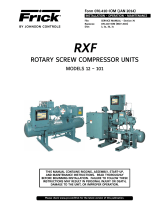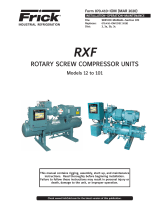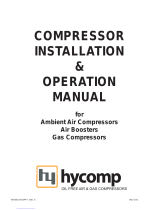
SCREW COMPRESSOR
FOUNDATIONS
Form 070.210-IB (MAY 2004)
INSTALLATION BULLETIN
File: SERVICE MANUAL - Section 70
Replaces: S70-210 IB/FEB 93
Please check www.johnsoncontrols.com/frick for the latest version of this publication.

SCREW COMPRESSOR FOUNDATIONS
General
The rst requirement of the compressor foundation is that it must be able to
support the weight of the compressor package including coolers, oil, and refrigerant
charge.
Screw compressors are manufactured to extremely low levels of rotating imbal-
ance and because of this do not generally require the massive foundations used with
older reciprocating compressors or large engines. However, it must be recognized that
screw compressors are capable of converting large quantities of shaft power into gas
compression in a relatively small space and that the installation of any high-speed,
high-power equipment should not be approached casually. The predominant frequency
of vibration produced in a screw compressor package is at lobe-passing frequency. This
is normally 200 to 600 Hertz, depending on drive speed and compressor model. Much
less mass is required to effectively dampen these relatively high-frequency vibrations
compared to low-frequency vibrations found in lower speed equipment.
Firmly anchoring the compressor package to a suitable foundation by proper
application of grout and elimination of piping stress imposed on the compressor is the
best insurance for a trouble-free installation. While a compressor may operate success-
fully on a poor foundation it is certain that vibration levels on the compressor package,
and noise levels emanating from the compressor package will be higher if it is not rmly
tied to the foundation mass. It is not unusual to see a ten fold increase in vibration level
measured on a screw compressor package when comparing a properly mounted pack-
age to one that is not tied to the foundation mass.
Use only the certied general arrangement drawings from Frick to determine the
mounting foot locations and to allow for recommended clearances around the unit for
ease of operation and servicing. Foundations must be in compliance with local building
codes and materials should be of industrial quality.

Preferred Installation Method - Concrete Foundations
Preparation and Anchoring
The oor should be a minimum of 6 inches of reinforced concrete. Anchor bolts
are required to rmly tie the unit to the oor. If the oor is new, it is recommended that
“L” or “J” type anchor bolts be installed at the time the concrete is being poured, at the
correct locations for the foot anchor holes on the package. If desired, temporary sleeves
can be used around the upper portion of the anchor bolts to allow slight adjustment in
bolt position prior to application of nal grout, (Figure A). These temporary sleeves are
to keep the concrete away from the upper surfaces of the anchor bolts. The clearance
around the bolts must be lled completely during the grouting process, (Figure B).
SECTION OF PIPE OR SLEEVE MADE FROM TIN SPOUTING.
USED TO KEEP CONCRETE AWAY FROM ANCHOR BOLT
DURING POURING OF HOUSEKEEPING PAD.
SLEEVE I.D. = 3 TIMES BOLT DIAMETER
CONCRETE FLOOR
HOUSEKEEPING PAD

For compressor packages being installed on existing concrete ooring, high
quality expanding anchors can be used. These anchors are considered wedge type and
must be designed to withstand vibratory loading. The material type should be stainless
steel (grades 303, 304, or 316) and the diameter should be 1/8” smaller than the hole
in the stand assembly. The concrete must meet the minimum strength as specied by
the manufacturer of the anchor. The anchor bolts must be of sufcient length to extend
from the base through the housekeeping pads and through the steel frame of the pack-
age, allowing 1 inch for grout installation. In addition, the anchor bolt must maintain a
minimum insertion depth into the base oor as specied by the anchor manufacturer.
STEEL LEVELING SHIMS NOT
BLOCKING GROUT FLOW
INTO ANCHOR HOLES.
GROUT MUST FLOW INTO ANCHOR HOLES
DURING GROUTING IF SLEEVES ARE USED.

HOUSEKEEPING PAD UNDER ENTIRE UNIT
HOUSEKEEPING PADS UNDER FEET ONLY
Figure C

Once the concrete foundation is cured, the unit can be rigged into proper posi-
tion. Use proper lifting points as dened in the Installation Operation and Maintenance
manual. Please note that some units, particularly with installed oil coolers or economiz-
er vessels, can be top heavy. Caution must be exercised to avoid tipping the unit.
The unit is rst positioned with the anchor bolts passing through the attachment
holes in the feet. The feet must then be shimmed in order to level the unit. The shims
should be placed to position the feet roughly one inch above the housekeeping pad to
allow room for grouting. If sleeves were used around the anchor bolts the unit should be
shimmed at some other position in order to allow the grout to ll the space around the
anchor bolts. If sleeves were not used around the anchor bolts, then steel shims can be
used under each anchor bolt position.
Leveling and Grouting
The unit should be leveled in both directions, primarily for aesthetics and square
piping connections, and should bare equally on all shim locations. Wet the concrete pad
in accordance with the grout manufacturer’s instructions.
STEEL COMPRESSOR BASE
EXPANDING ANCHORS
FOR EXISTING FLOORS
EPOXY GROUT
L OR J ANCHORS
FOR NEW FLOORS
STEEL LEVELING SHIMS
1" GROUT
6"
HOUSEKEEPING
PAD
6"
MINIMUM
CONCRETE
FLOOR

Mix a sufcient quantity of grout. An expansion-type epoxy grout must be used.
We have had good experience with Chockfast® Foundation System products, although
other high quality, nonshrinking grouts are also acceptable. Follow the manufacturer’s
recommendations for setting, precautions, mixing, working time, grout placement, n-
ishing, and curing.
The grout must be worked under all areas of the base with no voids. If the grout
is allowed to settle with a slight outward slope, oil and water will be able to run off the
base.
All metallic-based grouts should be sealed after curing to prevent oxidation from
destroying the grout.
Once the grout is fully cured, tighten the anchor bolts.
Installation on a Steel Base
When a Frick
®
screw compressor package is to be installed in a customer-pack-
aged refrigeration system, it is common to mount the compressor unit directly onto a
steel system base. In these cases the design of the system base and the mounting of the
system base to the customers foundation are very important factors in minimizing vibra-
tion. The following guidelines are provided as an aid in properly designing a system base.
1. Use I beams in the skid where the screw compressor will be attached to the sys-
tem base. The I beams should run parallel to the package feet and support the
feet for their full length.
2. The compressor unit feet should be continuously welded to the system base at
all points of contact.
3. The compressor unit should not be mounted on vibration isolators in order to
hold vibration levels down on the package.
4. The customer’s foundation for the system base should fully support the system
base under all areas, but most certainly under the I beams that support the com-
pressor package.
5. The system base should be leveled and grouted to the customers foundation
with the same precautions as noted above for a single compressor unit mounted
directly on concrete.
6. The system base should be rmly bolted to the customers foundation with suit-
able anchor bolts.

7. Whenever possible, the entire system base should be designed without piping
runs inside of the I beam base.
8.
Whenever possible the system base should be completely lled with concrete as
an added precaution to prevent vibration. The concrete must be allowed to fully
cure without the unit operating so it will maintain contact with the steel structure.
9. To attach a compressor base to a foundation, use anchor bolts at the primary
points on the skid where component weight bears on the main beams, not be-
tween main load bearing locations. See Figure E. Additional anchor points can be
used to supplement attachment, as long as the load-bearing points are included
as primary anchor locations.
Installation on Upper Floors of Buildings
When screw compressors are to be mounted on upper oors of buildings, extra
precautions should be taken to prevent normal package vibration from being trans-
ferred to the building structure where it might cause unacceptable noise or vibration. It
is important that no structural resonance of the building is near the primary frequencies
generated by the screw compressor, (lobe passing frequency and its harmonics). If this
is the case the vibration levels of the screw compressor unit can be greatly magnied by
the structure of the building.
When a compressor is to be mounted directly on a steel building structure,
it is essential to use rubber or spring isolators, or a combination of both, to prevent
the transmission of compressor vibration directly to the structure. The choice of the

proper type of isolation is important. Neoprene rubber isolation pads (VMC Shear-Flex
for example) have been used effectively in many applications. Pad type and surface
area (square inches) are based on total weight and deection of the pad. In applica-
tions where very low levels of transmitted vibration are required, spring isolators may
be necessary. It is best to employ a vibration expert in the design of a proper mounting
arrangement, taking account of spring, mass, and damping requirements to meet the
customer’s desired end result.
If a screw compressor package is fully isolated from the foundation, and not tied
to any structural mass, the vibration and noise levels on the screw compressor package
will likely be higher than typically encountered in the more normal concrete base instal-
lations because the vibrating components are not tied to any foundation mass.
The mounting and support of suction and discharge lines is also very important in
situations with the compressor isolated from the structure. Even with very effective isola-
tion of the compressor feet to the building, any piping that is tied directly to the structure
can also transmit noise and negate the advantages of isolation. Rubber or spring pipe
supports are generally required to avoid exciting the building structure at any pipe sup-
ports close to the compressor package.
All metal contact paths from an isolated package to the foundation must be broken.
For example, metal conduit from skid to oor should not be used.
Piping Stress
In any screw compressor installation, once the package is installed, properly
grouted, and anchored, it is important that the piping bolted to the screw compres-
sor not impose excessive forces or moments on the compressor. Suction and discharge
lines should be supported in pipe hangers so that the lines won’t move if disconnected
from the compressor. The Table on the back cover gives maximum allowable ange
loadings for various size compressors.
Gas or Diesel Engine Driven Packages
It is becoming more common to drive screw compressors with large stationary
engine or turbine drives in order to reduce electrical demand or reduce electric energy
consumption. Some special considerations should be given to foundations for engine
drives in order to avoid vibration problems on these skids.
1. The engine or turbine manufacturer will normally give foundation mass require-
ments for the driver. These are normally much heavier than would be used with
an electric motor driven screw compressor. A typical, large (500 HP), gas en-
gine drive may require 4 feet of concrete foundation thickness under the engine
in order to absorb the normal vibration associated with the engine. When the

engine is skid mounted with a screw compressor, it is not acceptable to spread
the recommended foundation mass requirement for the engine under the entire
screw compressor driveline. In other words, 1 ft thick concrete under a
20 ft long package is not equivalent to 4 ft thick concrete under the 5 ft length of
the engine. The foundation requirement for the engine must be under the engine.
Too much foundation will never hurt, but as a minimum the engine must be over
and rmly anchored to its required foundation mass.
A licensed architect should be consulted to determine the proper foundation re-
quirements for any large engine or turbine drive.
2. A torsional vibration analysis should always be performed by a capable party
before nal component selection in order to avoid torsional resonance in any
engine or turbine-driven screw compressor. This analysis will determine the
recommended coupling inertia and stiffness to tune the system torsional natural
frequency, and its harmonics, away from the operating speed or speeds. Once
the proper couplings have been specied, no substitutions should be made unless
the substitute coupling type is again checked by a new torsional analysis.
3. The attachment of an engine or turbine base to a screw compressor must be of
sufcient rigidity to maintain coupling alignment specications at the compres-
sor. For Frick compressors this is normally within .004 inch TIR radial and axial.
It is recommended that the driver and compressor be on the same structural
steel skid or that separate skids for the driver and compressor be bolted together
through dowelled connection pads.
4. Engine drive compressor packages can be quite heavy and the weight will nor-
mally be concentrated on the engine end of the skid. Extra precaution should be
exercised in lifting and rigging of large heavy skids. It is likely that the greatest
stress on the skid will occur during rigging and lifting into position. Improper lifts
can permanently distort a skid and be very expensive to x. Before rigging and
lifting a heavy skid, make sure adequate lifting points are being properly sup-
ported.
5. As an option on engine driven screw compressors, the system designer should
always consider the cost of a gear driven speed increaser between the engine
and compressor compared to a direct-driven larger compressor to produce the
same displacement. The larger direct drive compressor will have a considerably
simpler drive and coupling arrangement and simpler alignment procedures. This
will normally produce lower noise and vibration levels and may be more cost ef-
fective as well.

High Power Applications
Screw compressors are very exible in their ability to compress a wide variety
of gases over a wide range of pressures. In general, those applications with high suc-
tion and discharge pressures on dense gases will absorb the greatest power per unit
displacement. The more energy involved in the compression, the stronger the gas
pulsations will be coming out of the compressor discharge ports. These pulsations are
the driving force to excite the oil separator and discharge line to act like a speaker and
produce noise, as well as to produce structure-born vibration. An application at 350 psi.
discharge pressures on a dense refrigerant can be expected to produce more noise and
vibration than the same compressor at 200 psi. discharge pressure or compressing a
refrigerant of lower density.
In applying screw compressors at high pressures, the customer must be prepared
for the fact that package vibration and noise will be higher than the values predicted
for normal refrigeration duty. Proper foundations and proper installation methods are
vital at high power conditions and even then, the customer must be prepared for the
possibility that sound attenuation or noise curtains may be required to reduce noise to
desired levels. Because many applications are somewhat different from previous ex-
perience, it is impossible to accurately predict overall noise and vibration levels before
equipment is started and running at plant conditions.
The guidelines given in this paper can prevent most noise and vibration prob-
lems with screw compressors, but for high pressure custom applications, a guaranteed
noise level is impossible to predict prior to installation. Customer expectations must be
tempered with the understanding that customized compression systems will vary from
one application to another in achieved noise and vibration levels. If these issues are ad-
dressed before a system is installed, a more satised end user will be the result.

M
R
PMC
ML
VL
VC
ALLOWABLE FLANGE LOADS : ANSI CLASS 150, 300
NOZZLE MOMENTS LOAD
SIZE (ft-lbf) (lbf)
NPS AXIAL VERTICAL LATERAL AXIAL VERTICAL LATERAL
INCHES Mg Mc ML P VC VL
1 25 25 25 50 50 50
1.25 25 25 25 50 50 50
1.5 50 40 40 100 75 75
2 100 70 70 150 125 125
3 250 175 175 225 250 250
4 400 200 200 300 400 400
5 425 400 400 400 450 450
6 1000 750 750 650 650 650
8 1500 1000 1000 1500 900 900
10 1500 1200 1200 1500 1200 1200
12 1500 1500 1500 1500 1500 1500
14 2000 1800 1800 1700 2000 2000
External piping loads impose forces and moments in three geometric planes. Since cir-
cumstances vary from installation to installation, there is no one set of ange loading
values which Frick can provide for all cases. Our experience indicates that maintenance
of coupling alignment, especially for compressors and pumps, is the critical limiting fac-
tor. From a practical or service point of view, alignment is more of a concern than ange
strength, pipe stress, joint stress, casing stress, etc.
Although the ideal loading on any ange or connection is “zero”, it is not practical to ex-
pect “no” affect from external piping forces and thermal expansion.
The above Table reects a realistic approach to allowable ange loadings and provides
some guideline for the installation of Frick equipment.
100 CV Avenue
Waynesboro, PA 17268-1206 USA
Phone: 717-762-2121 • FAX: 717-762-8624
Supersedes: S70-210 IB (1993-02)
Subject to change without notice
Published in USA • GUI 1C
© 2013 Johnson Controls Inc. - ALL RIGHTS RESERVED
/










